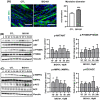BIO101 stimulates myoblast differentiation and improves muscle function in adult and old mice
- PMID: 38064183
- PMCID: PMC10834314
- DOI: 10.1002/jcsm.13326
BIO101 stimulates myoblast differentiation and improves muscle function in adult and old mice
Abstract
Background: Muscle aging is associated with a consistent decrease in the ability of muscle tissue to regenerate following intrinsic muscle degradation, injury or overuse. Age-related imbalance of protein synthesis and degradation, mainly regulated by AKT/mTOR pathway, leads to progressive loss of muscle mass. Maintenance of anabolic and regenerative capacities of skeletal muscles may be regarded as a therapeutic option for sarcopenia and other muscle wasting diseases. Our previous studies have demonstrated that BIO101, a pharmaceutical grade 20-hydroxyecdysone, increases protein synthesis through the activation of MAS receptor involved in the protective arm of renin-angiotensin-aldosterone system. The purpose of the present study was to assess the anabolic and pro-differentiating properties of BIO101 on C2C12 muscle cells in vitro and to investigate its effects on adult and old mice models in vivo.
Methods: The effects of BIO101 on C2C12 differentiation were assessed using myogenic transcription factors and protein expression of major kinases of AKT/mTOR pathway by Western blot. The in vivo effects of BIO101 have been investigated in BIO101 orally-treated (50 mg/kg/day) adult mice (3 months) for 28 days. To demonstrate potential beneficial effect of BIO101 treatment in a sarcopenic mouse model, we use orally treated 22-month-old C57Bl6/J mice, for 14 weeks with vehicle or BIO101. Mice body and muscle weight were recorded. Physical performances were assessed using running capacity and muscle contractility tests.
Results: Anabolic properties of BIO101 were confirmed by the rapid activation of AKT/mTOR, leading to an increase of C2C12 myotubes diameters (+26%, P < 0.001). Pro-differentiating effects of BIO101 on C2C12 myoblasts were revealed by increased expression of muscle-specific differentiation transcription factors (MyoD, myogenin), resulting in increased fusion index and number of nuclei per myotube (+39% and +53%, respectively, at day 6). These effects of BIO101 were like those of angiotensin (1-7) and were abolished with the use of A779, a MAS receptor specific antagonist. Chronic BIO101 oral treatment induced AKT/mTOR activation and anabolic effects accompanied with improved physical performances in adult and old animals (maximal running distance and maximal running velocity).
Conclusions: Our data suggest beneficial anabolic and pro-differentiating effects of BIO101 rendering BIO101 a potent drug candidate for treating sarcopenia and possibly other muscle wasting disorders.
Keywords: 20-hydroxyecdysone (20E); Ecdysteroids; MAS receptor; Muscle cell differentiation; Renin-angiotensin-aldosterone system (RAAS); Sarcopenia.
© 2023 Biophytis. Journal of Cachexia, Sarcopenia and Muscle published by Wiley Periodicals LLC.
Conflict of interest statement
All authors are, or were, employees of Biophytis. Maria Serova owns stocks in Biophytis. Blaise Didry‐Barca owns stocks in Biophytis. Robin Deloux owns stocks in Biophytis. Stanislas Veillet owns stocks in Biophytis. René Lafont owns stocks in Biophytis. Pierre J. Dilda owns stocks in Biophytis. Mathilde Latil owns stocks in Biophytis.
Figures





References
-
- Vellas B, Fielding RA, Bens C, Bernabei R, Cawthon PM, Cederholm T, et al. Implications of ICD‐10 for sarcopenia clinical practice and clinical trials: report by the international conference on frailty and sarcopenia research task force. J Frailty Aging 2018;7:2–9. - PubMed
-
- Burd NA, Gorissen SH, Van Loon LJ. Anabolic resistance of muscle protein synthesis with aging. Exerc Sport Sci Rev 2013;41:169–173. - PubMed
-
- Blaauw B, Canato M, Agatea L, Toniolo L, Mammucari C, Masiero E, et al. Inducible activation of Akt increases skeletal muscle mass and force without satellite cell activation. FASEB J 2009;23:3896–3905. - PubMed
MeSH terms
Substances
LinkOut - more resources
Full Text Sources
Medical
Miscellaneous

